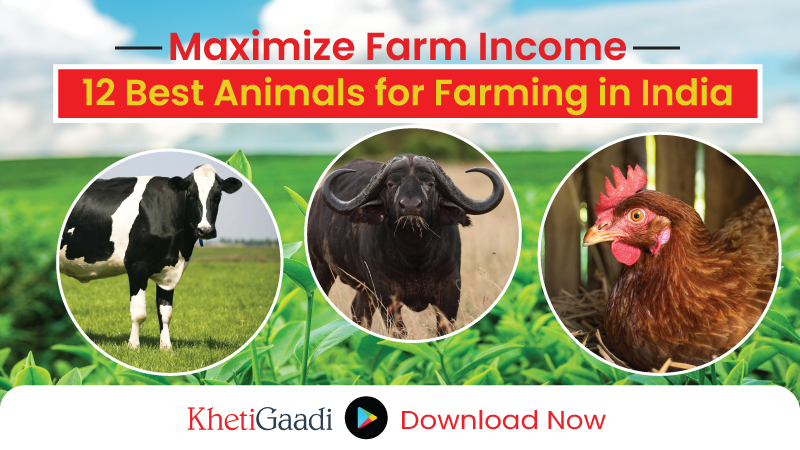A guide to learn about & earn from the top 12 farm animals
India has a long-standing tradition of animal husbandry, which plays a crucial role in the agricultural landscape. Farmers not only rely on crops but also gain substantial income from livestock. Choosing the right animals for farming can significantly increase profitability. Here’s a list of the top 12 animals that are best for Indian farms and farming, along with insights into their availability, maintenance costs, government support, benefits, and success stories.
1. Cows (Dairy Cattle)
- Availability: Widely available across India, especially indigenous breeds like Gir, Sahiwal, and Red Sindhi.
- Expenses: A healthy cow costs between ₹40,000 to ₹70,000, with yearly maintenance around ₹15,000 to ₹20,000 per cow.
- Govt Support: The National Dairy Development Board (NDDB) and schemes like Dairy Entrepreneurship Development Scheme (DEDS) offer subsidies.
- Benefits: High milk yield (Gir cows produce up to 12 litres/day), revenue from dairy, manure for farming, and even cow dung for biogas production.
- Success Story: The story of Mehsana farmers in Gujarat earning up to ₹1.5 lakh per month by maintaining Gir cows for dairy products.
2. Buffaloes
- Availability: Found nationwide, especially breeds like Murrah, Mehsana, and Jaffarabadi.
- Expenses: A Murrah buffalo costs around ₹50,000 to ₹1 lakh, with yearly upkeep around ₹10,000 to ₹15,000.
- Govt Support: NABARD and other financial institutions offer loans, and schemes like Rashtriya Gokul Mission assist in breed improvement.
- Benefits: High milk fat content (Murrah milk has 7-8% fat), used for making ghee and other products, boosting income.
- Success Story: Haryana’s buffalo farming cooperatives make a profit of over ₹2 crore annually, exporting milk products across India.
3. Goats
- Availability: Popular breeds like Beetal, Jamunapari, and Sirohi are common in northern and western India.
- Expenses: A single goat costs between ₹4,000 to ₹10,000, with annual maintenance at around ₹2,000 to ₹3,000.
- Govt Support: Various schemes, including NABARD’s subsidy for goat farming, offer financial assistance.
- Benefits: Goats are known for producing milk, meat, and manure, and are low maintenance compared to cattle.
- Success Story: A Rajasthan farmer started with 10 goats and now runs a 200-goat farm, earning ₹8 lakh per annum through goat farming.
4. Sheep
- Availability: Found in semi-arid regions, with breeds like Deccani, Nellore, and Garole.
- Expenses: A sheep costs between ₹3,000 to ₹6,000, with yearly maintenance of ₹1,500 to ₹2,000 per sheep.
- Govt Support: Government schemes like the Integrated Wool Development Programme provide subsidies.
- Benefits: Income from wool, meat, and manure. Wool production is in demand for the textile industry.
- Success Story: Andhra Pradesh’s sheep farmers earned ₹5 lakh/year through a cooperative model, supplying wool to local industries.
5. Poultry (Chickens)
- Availability: Widely available, especially breeds like Kadaknath, Rhode Island Red, and Vanaraja.
- Expenses: Poultry farming setup can range from ₹20,000 to ₹1 lakh, with yearly maintenance of ₹1,000 to ₹2,000 per bird.
- Govt Support: National Livestock Mission provides subsidies and loans for poultry farmers.
- Benefits: Income from eggs, meat, and manure, with low investment and high returns. Kadaknath chicken is sold at a premium price.
- Success Story: A farm in Madhya Pradesh makes over ₹10 lakh per year from raising Kadaknath chickens for high-quality meat and eggs.
6. Pigs
- Availability: Breeds like Large White Yorkshire and Landrace are common in states like Assam, Uttar Pradesh, and Bihar.
- Expenses: A piglet costs ₹2,000 to ₹3,000, with annual upkeep at around ₹5,000 per pig.
- Govt Support: The National Livestock Mission supports pig farming with subsidies and technical training.
- Benefits: High demand for pork in India and export markets. Pig farming is known for rapid return on investment due to the high reproduction rate.
- Success Story: Assam farmers make ₹5 lakh per year from a 20-pig farm, supplying meat to local markets and restaurants.
7. Fish (Aquaculture)
- Availability: India has a rich resource of freshwater and marine fish, with common species like Rohu, Catla, and Tilapia.
- Expenses: Initial setup costs can vary from ₹50,000 to ₹2 lakh, with yearly expenses depending on the scale of farming.
- Govt Support: Blue Revolution scheme provides subsidies, and technical support for fish farming.
- Benefits: High demand for fish across India, with income potential from both domestic and export markets.
- Success Story: Andhra Pradesh fish farmers reported earnings of over ₹25 lakh/year by employing modern aquaculture techniques.
8. Ducks
- Availability: Popular breeds include Khaki Campbell and Indian Runner, commonly found in states like Kerala and West Bengal.
- Expenses: Duck farming setup costs ₹10,000 to ₹50,000, with yearly expenses of ₹1,000 per duck.
- Govt Support: The Department of Animal Husbandry offers subsidies for duck farming under integrated livestock schemes.
- Benefits: Duck eggs and meat are in high demand, and they also help in pest control in paddy fields.
- Success Story: A West Bengal farmer earns ₹7 lakh per year from duck farming by selling eggs and meat to local markets.
9. Rabbits
- Availability: Rabbit farming is growing in popularity, with breeds like New Zealand White and Flemish Giant.
- Expenses: A rabbit costs ₹1,500 to ₹3,000, with yearly maintenance of ₹500 per rabbit.
- Govt Support: Animal Husbandry Department offers loans and subsidies for small-scale rabbit farming.
- Benefits: Low maintenance and high reproduction rate make rabbits ideal for meat and fur production.
- Success Story: Tamil Nadu farmers are earning up to ₹3 lakh per year from rabbit farming, with meat in high demand for local delicacies.
10. Honeybees (Apiculture)
- Availability: Beekeeping is widely practiced in states like Punjab, West Bengal, and Himachal Pradesh, with species like Apis cerana and Apis mellifera.
- Expenses: Initial investment for beekeeping is around ₹10,000 to ₹50,000.
- Govt Support: National Beekeeping & Honey Mission (NBHM) provides technical support and subsidies for beekeeping.
- Benefits: Income from honey, beeswax, and propolis, with high demand for organic products.
- Success Story: A Himachal Pradesh farmer earns ₹12 lakh/year from honey production and value-added products like beeswax candles.
11. Camels
- Availability: Mainly found in Rajasthan, with breeds like Bikaneri and Jaisalmeri.
- Expenses: A camel costs ₹30,000 to ₹50,000, with annual upkeep around ₹10,000.
- Govt Support: Rajasthan government provides financial aid for camel rearing under the Camel Conservation Scheme.
- Benefits: Camel milk is in high demand due to its health benefits, and camels are also used for transport and tourism.
- Success Story: Rajasthan’s camel herders earn ₹5 lakh/year by selling camel milk and related products.
12. Yaks
- Availability: Primarily found in high-altitude regions like Ladakh and Sikkim.
- Expenses: A yak costs around ₹25,000 to ₹40,000, with yearly upkeep depending on local conditions.
- Govt Support: The Livestock Mission provides financial and technical support for yak farming in mountainous regions.
- Benefits: Yak milk, meat, and wool are highly valued, with potential for value-added products like yak cheese.
- Success Story: Ladakhi yak herders are earning ₹8 lakh/year by selling wool and yak products to local and international markets.
Conclusion
Animal husbandry in India offers numerous opportunities for farmers to diversify their income sources. Whether it’s dairy farming, poultry, or aquaculture, each of these animals plays a crucial role in enhancing the economic stability of farming families across the country.
Relevant Links
Tags




